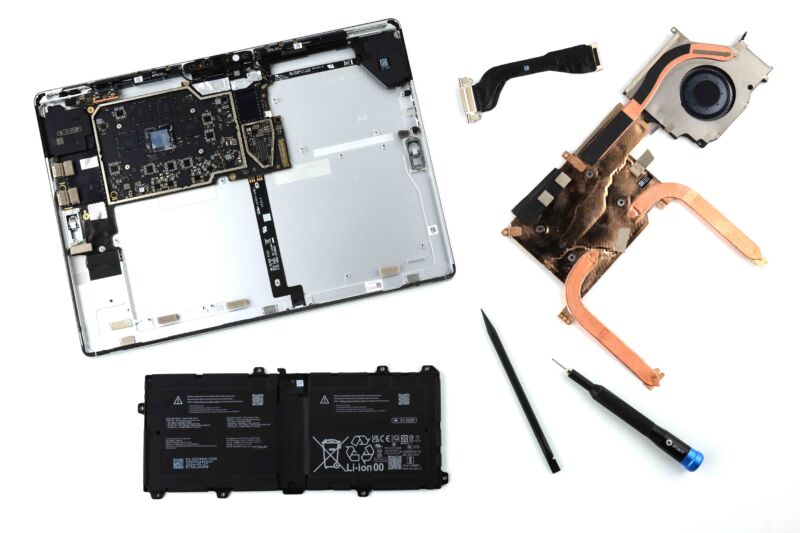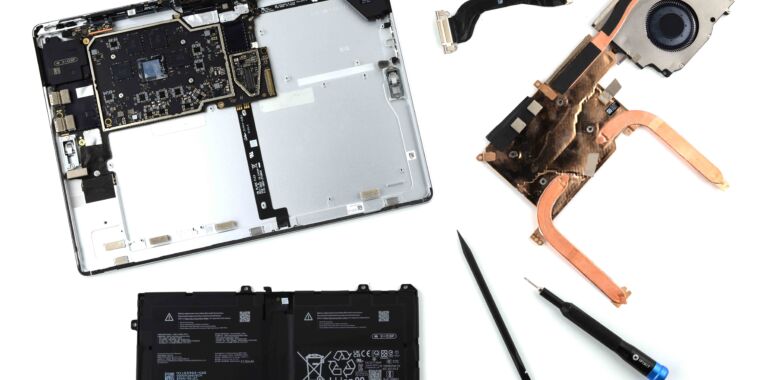
For a long time, Microsoft’s Surface hardware was difficult-to-impossible to open and repair, and devices as recent as 2019’s Surface Pro 7 still managed a repairability score of just 1 out of 10 on iFixit’s scale. 2017’s original Surface Laptop needed to be physically sliced apart to access its internals, making it essentially impossible to try to fix the machine without destroying it.
But in recent years, partly due to pressure from shareholders and others, Microsoft has made an earnest effort to improve the repairability of its devices. The company has published detailed repair manuals and videos and has made changes to its hardware designs over the years to make it easier to open them without breaking them and easier to replace parts once you’re inside. Microsoft also sells some first-party parts for repairs, though not every part from every Surface is available, and Microsoft and iFixit have partnered to offer other parts as well.
Now, iFixit has torn apart the most recent Snapdragon X-powered Surface Pro and Surface Laptop devices and has mostly high praise for both devices in its preliminary teardown video. Both devices earn an 8 out of 10 on iFixit’s repairability scale, thanks to Microsoft’s first-party service manuals, the relative ease with which both devices can be opened, and clearly labeled internal components.
Beneath the Surface
To open the Surface Laptop, iFixit says you only need to undo four screws, hidden beneath the laptop’s rubber feet; at that point, the bottom of the machine is only attached by magnets, rather than breakable retention clips. Opening the bottom of the laptop provides easy access to the battery and an M.2 2232 SSD. Labels inside the device indicate which screws need to be removed to replace which parts, and what kind of screwdriver you’ll need to do the job; scannable barcodes also make it easier to find repair manuals and parts on Microsoft’s site. Most other parts are easy to remove and replace once the bottom of the laptop is off.
The Surface Pro’s best repairability feature remains its easily accessible M.2 2232 SSD, present under a pop-off cover on the back of the tablet. From there, things get more difficult—accessing the battery and other components requires removing the screen, which is still held in place with adhesive rather than screws or magnets. This adhesive needs to be removed—iFixit cut it away with a thin plastic tool, and closing the tablet back up securely would likely require new adhesive to be applied. Once inside, the parts and screws are still labeled clearly, but you do need to remove the entire heatsink before you can replace the battery.
iFixit uses slightly different criteria for evaluating the repairability of laptops and tablets since tablets are more tightly integrated devices. So despite the identical repairability scores, the Surface Pro remains slightly more difficult to open and fix than the laptop; iFixit is just comparing it to devices like the iPad Air and Pro rather than other PC laptops, and the Surface Pro still looks better than other tablets by comparison despite the use of adhesive.
The teardown video didn’t detail exactly why iFixit knocked points off of each device’s repairability score, though iFixit took note of the soldered-down non-upgradeable RAM and Wi-Fi/Bluetooth modules. Both devices also use way more screws and clips than something like the Framework Laptop, which could also be a factor.
We’ve been using the new Snapdragon-powered Surface devices for a few days now, and we’ll have more thoughts to share about the hardware and its performance in the coming days.

